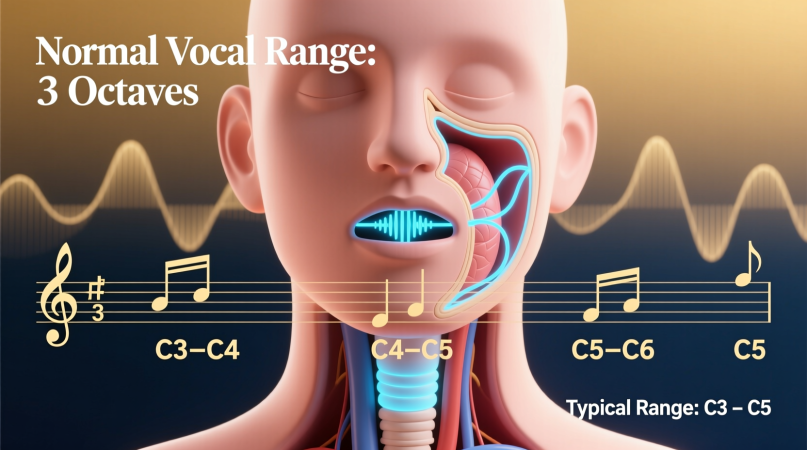
When singers talk about their abilities, one of the first things they compare is vocal range. But what’s considered “normal”? Is two octaves enough, or should you aim for more? Let’s break it down and see what the average person — and professional singers — can do.
What Is Vocal Range in Octaves?
Your vocal range is simply the span between your lowest and highest comfortable note. In music theory, this is measured in octaves.
For instance:
- A person singing from C3 to C5 has a two-octave range.
- A singer reaching A2 to A5 covers three octaves.
What’s the Typical Human Vocal Range?
For most people:
- Untrained voices: 1.5–2 octaves.
- Trained singers: 2.5–3 octaves.
- Exceptional voices: 4+ octaves.
So if you’re around two octaves, you’re in the normal range already. Expanding beyond that is possible with training, but it isn’t required to be a strong or expressive singer.
Male and Female Vocal Averages
Male Voices
Men usually fall lower in pitch:
- Bass: ~E2–E4
- Baritone: ~A2–A4
- Tenor: ~C3–C5
To see how you compare, check out the baritone vocal range guide.
Female Voices
Women sing higher:
- Alto: ~F3–F5
- Mezzo-soprano: ~A3–A5
- Soprano: ~C4–C6
Explore more in the soprano vocal range chart.
Famous Singers’ Ranges
Some singers push well beyond the average:
- Mariah Carey: ~5 octaves
- Freddie Mercury: ~4 octaves
- Axl Rose: ~5+ octaves
- Adele: ~2.5 octaves
But notice that Adele’s smaller range hasn’t stopped her from becoming a legendary vocalist. Tone and artistry matter more than raw octaves.
Why Vocal Range Differs
A few key factors:
- Genetics – Vocal cord length and structure.
- Training – Vocal exercises expand usable range.
- Age & health – Voices shift and sometimes shrink over time.
- Technique – Mastering transitions between registers (chest, head, falsetto).
Usable Range vs Absolute Range
It’s worth noting:
- A singer may squeak out a very high note but never use it in performance.
- The usable range (notes that sound controlled and strong) is what matters most.
That’s why many vocal coaches emphasize consistency over bragging rights.
How to Measure Your Range
Curious about your own voice?
- Start at a comfortable note and slide downward until you can’t go further.
- Then slide upward until your voice breaks.
- Count the distance in octaves.
You can also try an online vocal range test to see your results instantly. Or, for more precision, use the vocal range calculator tool.
Can Training Expand Your Octaves?
Yes — with:
- Daily scale practice.
- Smooth transitions between registers.
- Careful strengthening of weak notes.
Most people can add half an octave or more with dedicated practice. But don’t force it — vocal health always comes first.
FAQs About Normal Vocal Ranges
Q: Is 2 octaves a good range?
Yes — 2 octaves is average and enough for most singing styles.
Q: Is 3 octaves rare?
Not rare, but usually linked to trained singers.
Q: How many octaves do professionals sing?
Most pros comfortably cover 2–3 octaves.
Q: Does vocal range shrink with age?
Yes, but proper training helps maintain flexibility.
Q: Is vocal range genetic?
Partly — natural anatomy sets your baseline, but training expands it.
